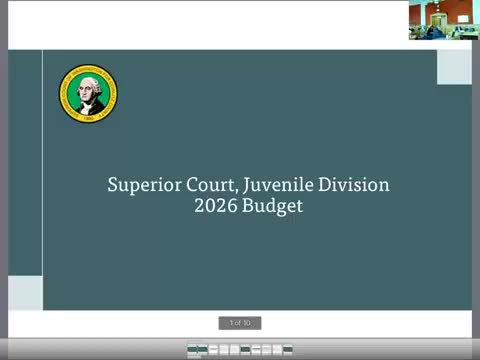Juvenile court warns of major grant cuts, detention costs rise in 2026 budget outlook
October 27, 2025 | Cowlitz County, Washington
This article was created by AI summarizing key points discussed. AI makes mistakes, so for full details and context, please refer to the video of the full meeting. Please report any errors so we can fix them. Report an error »

Patricia Fassett, presiding judge of juvenile court, and George Moyer, juvenile court administrator, presented the juvenile court’s 2026 budget outlook to the Cowlitz County Board of Commissioners, covering both probation and detention.
Moyer said the probation budget request largely maintains current services while trimming discretionary items and achieving a roughly 10% reduction in expenditures from 2025 to 2026. He said projected revenue for probation is down substantially—about 32%—because multiple state and grant revenue sources have been reduced or eliminated.
On revenue, presenters highlighted three major changes driving the decline: a substantial cut to BECCA (truancy and at‑risk youth) funding that reduced passthrough support for Educational Service District 112 by about $154,000; a roughly 50% reduction in a DCYF (Department of Children, Youth & Families) grant, leaving about $20,000 for 2026; and the elimination of a 0.1% funding source that paid a clinician FTE. Combined, Moyer said the probation side anticipates roughly $324,000 less revenue for 2026.
Moyer described ongoing local tracking and reporting of program outcomes. He said the department maintains its own monthly and quarterly reporting for grants and has programs that currently show high completion rates; the office uses those data to check whether programs reduce recidivism and to inform state reporting.
On detention, presenters told the commissioners they expect a 7.19% increase in expenditures for 2026 driven in part by county‑level insurance and IT allocations beyond the department’s control and by cost increases in a new medical contract that covers care for youth in custody. The detention presentation itemized operating increases: professional services (+$100,000), internal insurance (+$35,000), industrial accident (+$3,000) and IT (+$9,000)—a combined increase the presenters said is roughly $147,000.
Revenue for detention is harder to predict and was presented as down by about 37% in the county’s draft numbers; presenters said room‑and‑board contracts with other counties have historically provided intermittent revenue (example figure cited was about $55,000 currently expected), but those revenues depend on how many youth are placed and contract rates set by the state. Presenters noted one operational pressure: the county has seen more violent juvenile cases recently and a juvenile murder trial was beginning the same day.
Commissioners and staff discussed whether splitting administrative salaries between probation and detention would better reflect true costs; administrators recommended establishing combo codes to allocate personnel time across programs and suggested a roughly 50/50 split for some shared administrative roles.
Ending: Staff said they would continue to refine revenue projections and suggested commissioners may consider discussions with other counties about facility consolidation, while noting statutory and practical obstacles and the possible downstream effects on counsel access and family visitation.
Moyer said the probation budget request largely maintains current services while trimming discretionary items and achieving a roughly 10% reduction in expenditures from 2025 to 2026. He said projected revenue for probation is down substantially—about 32%—because multiple state and grant revenue sources have been reduced or eliminated.
On revenue, presenters highlighted three major changes driving the decline: a substantial cut to BECCA (truancy and at‑risk youth) funding that reduced passthrough support for Educational Service District 112 by about $154,000; a roughly 50% reduction in a DCYF (Department of Children, Youth & Families) grant, leaving about $20,000 for 2026; and the elimination of a 0.1% funding source that paid a clinician FTE. Combined, Moyer said the probation side anticipates roughly $324,000 less revenue for 2026.
Moyer described ongoing local tracking and reporting of program outcomes. He said the department maintains its own monthly and quarterly reporting for grants and has programs that currently show high completion rates; the office uses those data to check whether programs reduce recidivism and to inform state reporting.
On detention, presenters told the commissioners they expect a 7.19% increase in expenditures for 2026 driven in part by county‑level insurance and IT allocations beyond the department’s control and by cost increases in a new medical contract that covers care for youth in custody. The detention presentation itemized operating increases: professional services (+$100,000), internal insurance (+$35,000), industrial accident (+$3,000) and IT (+$9,000)—a combined increase the presenters said is roughly $147,000.
Revenue for detention is harder to predict and was presented as down by about 37% in the county’s draft numbers; presenters said room‑and‑board contracts with other counties have historically provided intermittent revenue (example figure cited was about $55,000 currently expected), but those revenues depend on how many youth are placed and contract rates set by the state. Presenters noted one operational pressure: the county has seen more violent juvenile cases recently and a juvenile murder trial was beginning the same day.
Commissioners and staff discussed whether splitting administrative salaries between probation and detention would better reflect true costs; administrators recommended establishing combo codes to allocate personnel time across programs and suggested a roughly 50/50 split for some shared administrative roles.
Ending: Staff said they would continue to refine revenue projections and suggested commissioners may consider discussions with other counties about facility consolidation, while noting statutory and practical obstacles and the possible downstream effects on counsel access and family visitation.
View the Full Meeting & All Its Details
This article offers just a summary. Unlock complete video, transcripts, and insights as a Founder Member.
✓
Watch full, unedited meeting videos
✓
Search every word spoken in unlimited transcripts
✓
AI summaries & real-time alerts (all government levels)
✓
Permanent access to expanding government content
30-day money-back guarantee

